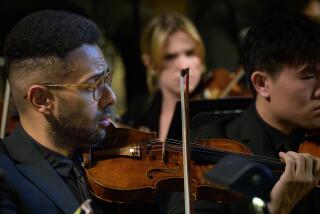Ax, Ma: aligned in magic
How do you define a great musical partnership? For pianist Emanuel Ax and cellist Yo-Yo Ma, longtime friends and colleagues, you can catch a subtle hint as early as their billing. The names of both artists -- who were cheered to the rafters when they stepped onto the Royce Hall stage Monday as part of the UCLA Live series -- appeared in type of equal size in the evening’s program. And Ax’s came first, even though Ma is usually regarded as the superstar.
More significant, Ma abandoned a cellist’s usual position in front of the piano to sit behind Ax’s back, so that the sound of both instruments emerged equally from along the same line. Although he had his own music stand and often played from memory, with his eyes closed, Ma also frequently appeared to glance over Ax’s right shoulder at the score on the piano.
He would listen intently, lean toward his friend and stretch back in delight, both at what he heard and what he could contribute. When he looked forward, smiled and bent toward the audience, everyone was brought into a magical, intimate circle. It didn’t hurt that the playing was superb.
The positioning made sense in terms of most of the programming. All the works were by Beethoven, who, according to program notes by Los Angeles Philharmonic annotator John Mangum, made the cello sonata a vehicle for serious expression.
But the composer made it that way in stages. In the order in which they were played: The Sonata No. 1 explores the possibilities of the relationship, with the piano leading and the cello only beginning to find its voice. By Sonata No. 4, the two are old friends who don’t have to talk about important things to communicate (at least at first) but who also don’t hesitate to venture together into undiscovered, even dangerous, territory.
The Sonata No. 3 benefits from more polarized, dramatic tension. But Ma’s position here minimized the opposition and sounded a weaker voice.
Ax played throughout with pearly, rippling, understated evenness. He provided the wit and the gleaming architecture. Ma added the passion. In two sets of variations on arias from Mozart’s “The Magic Flute” (“Ein Madchen oder Weibchen” and “Bei Mannern, welche Liebe fuhlen”), the two joked and charmed each other and entranced the audience.
They played the slow movement from Chopin’s Sonata in G minor for cello and piano as their single encore. Note: cello and piano. The partnership remained intact to the end.
More to Read
The biggest entertainment stories
Get our big stories about Hollywood, film, television, music, arts, culture and more right in your inbox as soon as they publish.
You may occasionally receive promotional content from the Los Angeles Times.










